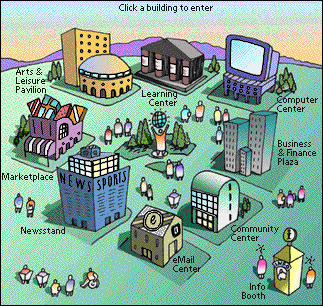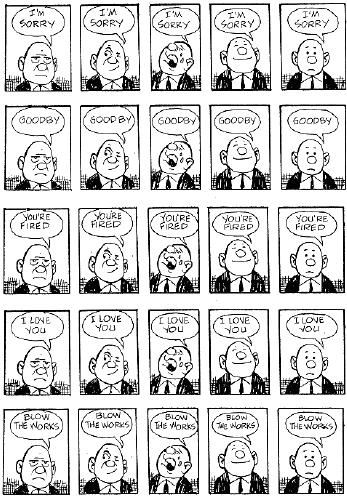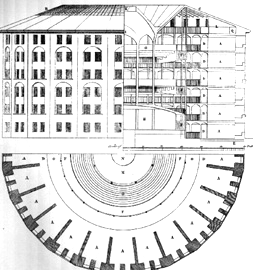The metaphor of the city is a very useful tool for thinking about the virtual world. The virtual world is abstract and unknown; the city is physical and, though very complex, better known. Here I will look at some of the key parallels between real cities and virtual spaces and between city architects and on-line system designers.
A metaphor is a cognitive tool, a way of structuring thought. In particular, metaphor is useful (and arguably essential) for thinking about abstractions [2]. The cultural and symbolic meaning of ``city'' helps shape our conception of what this new world should be like; using the metaphor transfers the meaning of ``city'' to the abstract virtual environment ( Leiss et al. 1990; Eco 1984). And, while the net is ``fundamentally and profoundly anti-spatial'' (Mitchell 1995), a physical metaphor makes the abstract comprehensible: our constant experience of the spatial world makes such metaphors both powerful and pervasive (Lakoff and Johnson 1980).
There are parallels both between real-world cities and virtual environments as well as between real-world architect and virtual system designers. Both real-world and virtual cities are (or should be) vibrant gathering places of people, centers of commerce and entertainment. The designers of both urban spaces and of virtual system are creating environments that influence the interactions that occur within them and the culture that grows around them. But there are also important differences. In the real world, the designer creates a solid infrastructure of buildings, streets, etc., around which people and objects move. In the virtual world, the designer is working with very different materials and with a much more encompassing task. The whole communication structure and the means by which human beings are represented must be designed; it is as if an architect was responsible not only for making a building, but also the organs of sight by which the inhabitants viewed it.
2.1.1 Parallels: the real and the virtual city
Many points of comparison can be drawn between the physical and the virtual city. In City of Bits
(Mitchell 1995), William Mitchell surveys wide range of them, examining the city metaphor in roles ranging from the aesthetic and physical to the economic and political. His analysis highlights the key points of comparison in a series of analogies: ``Muscles / Actuators'', ``Facade / Interface'', ``Territory / Topology'', ``Enclosure / Encryption'', etc.
My focus is on the cultural and social parallels: on how the structure of the city affects the life within it and how cultural vocabularies and social institutions evolve in response.
2.1.1.1 The landscape of strangers
One of the strongest parallels between the city and the virtual world is their immense populations. Modern cities are filled with strangers, huge crowds of people one passes on the street but does not know. This is very different from life in a village. It is different even from life in the classical cities - the polis whose agora and civil life are so often cited in discussions of electronic community [3]. This continuous exposure to unknown persons, of diverse and often unfamiliar backgrounds and habits, has been cited by many urban theorists as one of the most salient characteristics of city life (
Canetti 1984;
Milgram 1977;
Sennett 1974;
Simmel 1971;
Wirth 1938).
The virtual world is similarly populated by millions of people, most of whom are strangers to each other. Examining how this population pattern has shaped real world city culture can help us understand the forces that are shaping the development of on-line cultures. Furthermore, the analogy can point to designs that may help the virtual city avoid some of the real city's problems; it can also suggest directions that may be especially fruitful to explore.
Ties in the virtual world are also weak. Here too, many of one's daily encounters with others show only a narrow facet of their lives and personalities, occurring as they do in specialized and limited venues (e.g. motorcyclist newsgroups, Perl programming forums, new parent chat spaces, etc.). As in the real world, the resulting anonymity is both liberating and alienating ( Donath n.d.; Sproull and Kiesler 1991). Anonymous on-line discussion spaces allow people to candidly discuss personal or controversial matters - one can, for example, seek information about a medical problem without making one's condition publicly known or discuss unpopular political beliefs without reprisal ( Froomkin 1995; May 1994). Yet anonymity is also cited as one of the reasons why on-line discussions so often degenerate into angry exchanges. Anonymity hides the offending writer from retribution. Furthermore, in an anonymous setting there are few reminders of the mores of social interaction, which are often cued by the identity of the other (e.g. one speaks - or avoids speaking - in certain ways in front of children or older people or one's boss or clergy, etc.).
Yet alienation need not be the inevitable result of immense population. Many urban theorists cite internal structures, such as close-knit neighborhoods, as constructs that provide an intermediate environment between the complete anonymity of the city at large and the deep relationships of close friends and family ( Jacobs 1992; Milgram 1977). For the designer of virtual environments, the analyses and solutions posed by their real-world counterparts can provide useful insights. Virtual neighborhoods are not a new concept ( Rheingold 1993; Mitchell 1995), but there is much still to be gathered from the metaphor in terms of understanding what the salient features of ``neighborhood'' are and what makes some neighborhoods particularly successful. For instance, both Jacobs (Jacobs 1992) and Whyte (Whyte 1988) emphasize the importance of mixed-use occupancy to strengthen neighborhoods; the combination of work, recreation and residential space, they say, bring a heterogeneous population and results in fuller utilization of the existing resources, especially over time, avoiding the emptiness of the business district at night or the suburban bedroom community by day. The concept of mixed-use can be carried to the virtual realm, inspiring the creation of venues that are accessed by varied groups. An example is the notion of ``surrounding neighborhoods'' on the web (see the discussion in Chapter 4 about multiple links to Portraits in Cyberspace and the wide range of opinions found in the on-line discussions there.)
The characteristics of the city - its density, size, heterogeneity - have elicited cultural responses that are distinctly urban. These responses show the adaptations people have made in order to best benefit from urban conditions. An especially interesting cultural development, from the point of view of the virtual designer, is fashion. The rise of fashion is an urban phenomenon. It has been attributed, in part, to the need to establish one's identity within a population of strangers, while also maintaining an essential privacy ( Ewen 1988; Sennett 1974). Describing how immigrants to the city became acculturated, Ewen wrote:
In such a broad milieu of strangers, style was a dramatic necessity. One was repeatedly made aware of self as other, of one's commodity status within a vast social marketplace, and style provided its user with a powerful medium of encounter and exchange... [S]tyle allowed one to put up a front, to protect one's inner self... True moderns, they were learning to internalize the dictum of Bishop Berkeley, that ``to be is to be perceived''. (
Ewen 1988)
The inhabitants of today's virtual environments are similarly faced with competing desires: to be known yet not be exposed. One can see today's Web home page as the cultural equivalent of clothing, a personal display created for public viewing. As I will discuss in Chapter 3, elements of the home page exhibit the social features of fashion: their meaning changes over time as their use shifts to different social groups and these changes may be attributable to conflicting goals of differentiation and imitation
(McCracken 1988).
2.1.1.2 The legible city
The design of the city affects not only how well its inhabitants can find their way around, but how well they can make sense of its social and symbolic complexities (
Lynch 1960;
Milgram 1977). Kevin Lynch, writing about importance of a ``legible'' environment, said:
Obviously a clear image enables one to move about easily and quickly: to find a friend's house or a policeman or a button store. But an ordered environment can do more than this; it may serve as a broad frame of reference, an organizer of activity or belief or knowledge... Like any good framework, such a structure gives the individual a possibility of choice and a starting-point for the acquisition of further information. A clear image of the surroundings is thus a useful basis for individual growth. (
Lynch 1960)
The inhabitants of the virtual city have similar needs. They need to be able to get from one place to another, to know what is available and who are their fellow inhabitants. The abstract nature of the on-line world makes a legible environment especially important: a poorly conceived interface is far more impenetrable than the most twisted alleyways.2.1.2 The architect and the system designer
The city metaphor extends also to the parallels between their respective builders: the urban architect and the designer of virtual spaces. The metaphor of system designer as city planner and architect is the basis of the methodology of this thesis.
The architect must understand the technology of buildings, the properties of materials and the forces that make buildings stay up (or fall down); the architect must also understand how the buildings and street plans and lighting designs will affect the people who inhabit them.
On one side there is the engineering side of building: a matter of calculating loads and stresses, of making joints watertight and roofs rainproof, of setting down foundations so solidly that the building that stands on them will not crack or sink. But on the other side there is the whole sphere of expression, the attempt to use the constructional forms in such a way as to convey the meaning of the building to the spectator and user, and enable him, with a fuller response on his own side, to participate in its functions - feeling more courtly when he enters a palace... more businesslike and efficient when he enters an office.... and more citizenlike, more cooperative and responsible, more proudly conscious of the community he serves when he goes about his city and participates in its many-sided life. Architecture, in the sense that I here present it to you, is the permanent setting of a culture against which its social drama can be played out with the fullest help to the actors. (
Mumford 1952)
Like the architect, the designer of the virtual space must also understand the technology, knowing what is feasible to build today or next year, and what problems, often seemingly simple ones, are still very far from a solution. And, like the architect, the designer's primary role is to create a social environment. Architecture may not determine human behavior, but... bad design can numb the human spirit and good design can have powerful, positive influences on human being. Of the many values designers seek to build into their designs perhaps none is more important than fostering community and human interaction. (
LeGates and Stout 1996)
There are, however, important differences between the role of the architect and of the designer of virtual spaces. In the real world, the built environment is only a small part of the environment as a whole. In the virtual world, the built environment is everything: it is a wholly mediated and synthetic world. The participants in a virtual world are wholly dependent upon the tools supplied by the creators of the space to communicate. The choices made by the designer of a virtual environment thus greatly influence and constrain the means of communication and the ways in which a cultural vocabulary develops. 2.1.3 Designing the new
The city metaphor has resonance and depth, for there are many parallels between the city and the virtual world, and the city metaphor provides many striking images with which to think about building on-line environments. It is thus not surprising that the metaphor is in common usage: Digital Cities and Electropolises and Downtown Cyberspaces abound. Yet, too often, the city metaphor is taken literally and the resulting interfaces do not provide the functions of a city; they merely replicate the facade.

|
| Apple's eworld takes the city metaphor quite literally. |
``Attention Virtual Shoppers... Now Entering Cyber City!'' is the welcoming banner on the web-page of alltelga.net, home thus far of Beckler's Carpet Outlet, Club Atlanta Travel and Kinard Realty, and where a cartoon of the still empty Main Street awaits more tenants. On many sites the city takes the shape of a graphical map, where various functions have been placed in appropriate, clickable buildings: email in the post office; shopping sites in the store; customer service complaints in the courthouse. Here the metaphor is used, but only superficially, the pictures simply substituting for a category label.
On other sites, the metaphor draws from rather questionable features of the subject. In GeoCities, ``our Homesteaders set up residency in one of our twenty-four themed communities, based on the content of their home page.'' Here, the creators are replicating the feel and function of carefully monitored, gated neighborhoods and regulated facades, what Sorkin called ``a generic urbanism inflected only by appliqué.'' (Sorkin 1992b)
The electronic city is endlessly mutable. Its structure can grow and change at rates inconceivable in a world of brick and stone; its appearance may be highly subjective, individually tailored to the taste of every visitor. The city metaphor works when it is applied functionally, i.e. when we think about the role of public spaces in social life and the use of landmarks in building collective memories.

